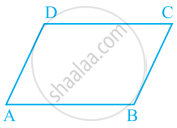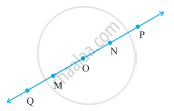Advertisements
Advertisements
Question
Answer the questions with the help of a given figure.

- State the points which are equidistant from point B.
- Write a pair of points equidistant from point Q.
- Find d(U, V), d(P, C), d(V, B), d(U, L).
Solution
(i) The co-ordinates of points B and C are 2 and 4 respectively.
We know that 4 > 2
∴ d(B, C) = 4 − 2
∴ d(B, C) = 2
The co-ordinates of points B and A are 2 and 0 respectively.
We know that 2 > 0
∴ d(B, A) = 2 − 0
∴ d(B, A) = 2
Since d(B, A) = d(B, C), then points A and C are equidistant from point B.
The co-ordinates of points B and D are 2 and 6 respectively.
We know that 6 > 2
∴ d(B, D) = 6 − 2
∴ d(B, D) = 4
The co-ordinates of points B and P are 2 and −2 respectively.
We know that 2 > − 2
∴ d(B, P) = 2 − (− 2)
∴ d(B, P) = 2 + 2
∴ d(B, P) = 4
Since d(B, D) = d(B, P), then points D and P are equidistant from point B.
(ii) The co-ordinates of points Q and U are −4 and −5 respectively.
We know that −4 > −5
∴ d(Q, U) = − 4 − (− 5)
∴ d(Q, U) = − 4 + 5
∴ d(Q, U) = 1
The co-ordinates of points Q and L are −4 and −3 respectively.
We know that − 3 > − 4
∴ d(Q, L) = −3 − (− 4)
∴ d(Q, L) = −3 + 4
∴ d(Q, L) = 1
Since d(Q, U) = d(Q, L), then points U and L are equidistant from point Q.
The co-ordinates of points Q and R are −4 and −6 respectively.
We know that − 4 > − 6
∴ d(Q, R) = −4 − (−6)
∴ d(Q, R) = −4 + 6
∴ d(Q, R) = 2
The co-ordinates of points Q and P are −4 and −2 respectively.
We know that −2 > − 4
∴ d(Q, P) = −2 − (− 4)
∴ d(Q, P) = −2 + 4
∴ d(Q, P) = 2
Since d(Q, R) = d(Q, P), then points R and P are equidistant from point Q.
(iii) The co-ordinates of points U and V are −5 and 5 respectively.
We know that 5 > − 5
∴ d(U, V) = 5 − (− 5)
∴ d(U, V) = 5 + 5
∴ d(U, V) = 10
The co-ordinates of points P and C are −2 and 4 respectively.
We know that 4 > −2
∴ d(P, C) = 4 − (− 2)
∴ d(P, C) = 4 + 2
∴ d(P, C) = 6
The co-ordinates of points V and B are 5 and 2 respectively.
We know that 5 > 2
∴ d(V, B) = 5 − 2
∴ d(V, B) = 3
The co-ordinates of points U and L are −5 and −3 respectively.
We know that − 3 > − 5
∴ d(U, L) = −3 − (−5)
∴ d(U, L) = −3 + 5
∴ d(U, L) = 2
APPEARS IN
RELATED QUESTIONS
The following table shows points on a number line and their co-ordinates. Decide whether the pair of segments given below the table are congruent or not.
| Point | A | B | C | D | E |
| Co-ordinate | -3 | 5 | 2 | -7 | 9 |
seg DE and seg AB
Point P is the midpoint of seg CD. If CP = 2.5, find l(CD).
Name all the line segments in figure
Name the points and then the line segments in the following figure:
Which points in figure, appear to be mid-points of the line segments? When you locate a mid-point, name the two equal line segments formed by it.
In which of the following figures, perpendicular bisector is shown?
How many line segments are there in given figure?
How many line segments are there in given figure? Name them.
Consider the following figure of line \[\overleftrightarrow{MN}\]. Say whether the following statement is true or false in the context of the given figure.

M and N are the end points of line segment `overline"MN"`.
Consider the following figure of line \[\overleftrightarrow{MN}\]. Say whether the following statement is true or false in the context of the given figure.

M is one of the end points of line segment `overline"QO"`.
